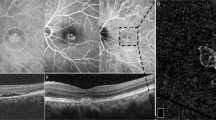Summary
Purpose
To describe the morphology of retinal and choroidal vessels in swept source optical coherence tomography angiography (SS-OCTA) in choroidal neovascularization (CNV) during the course of central serous chorioretinopathy (CSC). Additionally, to report intravitreal anti-VEGF (vascular endothelial growth factor) injection treatment results.
Methods
A case series of patients diagnosed with chronic central serous chorioretinopathy. Fluorescein angiography, spectral domain optical coherence tomography, and SS-OCTA were performed. Analysis of retina and choroidal vasculature was performed. All patients received anti-VEGF therapy.
Results
The study demonstrated pathological vessels in the retina avascular zone and at the level of choriocapillaris during the course of choroidal neovascularization in central serous chorioretinopathy. These vessels are invisible in fluorescein angiography, as they are hidden by pooling of the dye. These vessels correspond to a slightly hyper-reflective elevation of retinal pigment epithelium visible in optical coherence tomography. Visual acuity and central retinal thickness decreased after anti-VEGF treatment. The vessels did not completely disappear despite anti-VEGF treatment.
Conclusion
This study shows that SS-OCTA enables us to identify neovessels during the course of CSC. In diagnosing this entity, SS-OCTA appears superior to fluorescein angiography and might also enable us to decide on the best timing for anti-VEGF injections.
Zusammenfassung
Zweck
Die Morphologie retinaler und choroidaler Gefäße wird mittels „swept-source“ optischer Kohärenztomographie-Angiographie (SS-OCTA) bei choroidaler Neovaskularisation (CNV) im Verlauf einer zentralen serösen Chorioretinopathie beschrieben (CSC). Des Weiteren wird über die Ergebnisse der Behandlung mit intravitrealen Anti-VEGF-Injektionen berichtet.
Methoden
Es handelt sich um eine Fallserie von Patienten, bei denen eine chronische zentrale seröse Chorioretinopathie diagnostiziert wurde. Eine Fluoreszenzangiograpie, eine Spectral-Domain-optische Kohärenztomographie sowie eine SS-OCTA wurden durchgeführt. Es erfolgte eine Analyse der retinalen und choroidalen Gefäße. Die Patienten waren für eine VEGF-Therapie geeignet.
Ergebnisse
Die Studie zeigte pathologische Gefäße in der avaskulären Zone der Netzhaut sowie den Grad der Choriokapillaren im Verlauf einer choroidalen Neovaskularisation bei zentraler seröser Chorioretinopathie. Diese Gefäße sind in der Fluoreszenzangiographie nicht sichtbar, da sie vom verteilten Farbstoff verdeckt werden. Diese Gefäße gehen mit einer leichten hyperreflektiven Erhöhung des Netzhautpigmentepithels einher, die in der optischen Kohärenztomographie zu sehen ist. Die Akuität des Visus und die zentrale Netzhautdicke verringerten sich nach der Anti-VEGF-Therapie. Die Gefäße verschwanden jedoch trotz der Anti-VEGF-Behandlung nicht vollständig.
Schlussfolgerung
Diese Studie zeigt, dass die SS-OCTA die Identifizierung von Neogefäßen im Verlauf einer CSC ermöglicht. Bei der Diagnostik dieser Entität scheint die SS-OCTA der Fluoreszenzangiographie überlegen zu sein und könnte uns dabei helfen, den besten Zeitpunkt für die Anti-VEGF-Injektionen zu finden.



Similar content being viewed by others
References
Spaide RF, Campeas L, Haas A, Yannuzzi LA, Fisher Y, Guyer DR, Slakter JS, Sorenson JA, Orlock DA. Central serous chorioretinopathy in younger and older adults. Ophthalmology. 1996;103:2070–9. discussion 79–80.
Colucciello M. Choroidal neovascularization complicating photodynamic therapy for central serous retinopathy. Retina (Philadelphia, Pa). 2006;26(2):239–42.
Loo RH, Scott IU, Flynn HW Jr, Gass JD, Murray TG, Lewis ML, Rosenfeld PJ, Smiddy WE. Factors associated with reduced visual acuity during long-term follow-up of patients with idiopathic central serous chorioretinopathy. Retina (Philadelphia, Pa). 2002;22(1):19–24.
Fung AT, Yannuzzi LA, Freund KB. Type 1 (sub-retinal pigment epithelial) neovascularization in central serous chorioretinopathy masquerading as neovascular age-related macular degeneration. Retina (Philadelphia, Pa). 2012;32(9):1829–37.
Cakir B, Reich M, Lang SJ, Bühler A, Stahl A, Böhringer D, Agostini H, Lange C. Possibilities and Limitations of OCT-Angiography in Patients with Central Serous Chorioretinopathy. Klin Monbl Augenheilkd. 2017; doi:10.1055/s-0043-102576.
Weng S, Mao L, Yu S, Gong Y, Cheng L, Chen X. Detection of choroidal neovascularization in central serous chorioretinopathy using optical coherence tomographic angiography. Ophthalmologica. 2016;236(2):114–21.
Imamura Y, Fujiwara T, Margolis R, Spaide RF. Enhanced depth imaging optical coherence tomography of the choroid in central serous chorioretinopathy. Retina (Philadelphia, Pa). 2009;29(10):1469–73. doi:10.1097/iae.0b013e3181be0a83.
Mudvari SS, Goff MJ, Fu AD, McDonald HR, Johnson RN, Ai E, Jumper JM. The natural history of pigment epithelial detachment associated with central serous chorioretinopathy. Retina (Philadelphia, Pa). 2007;27:1168–73.
Schatz H, Madeira D, Johnson RN, McDonald HR. Central serous chorioretinopathy occurring in patients 60 years of age and older. Ophthalmology. 1992;99:63–7.
Peiretti E, Ferrara DC, Caminiti G, Mura M, Hughes J. Choroidal neovascularization in caucasian patients with longstanding central serous chorioretinopathy. Retina (Philadelphia, Pa). 2015;35(7):1360–7.
Chhablani J, Pichi F, Silva R, Casella AM, Murthy H, Banker A, Nowilaty SR, Carrai P, Nucci P, Arevalo JF, King Khaled Eye Specialist Hospital International Collaborative Retina Study Group. Antiangiogenics in choroidal neovascularization associated with laser in central serous chorioretinopathy. Retina (Philadelphia, Pa). 2016;36(5):901–8. doi:10.1097/iae.0000000000000804.
Coscas GJ, Lupidi M, Coscas F, Cagini C, Souied EH. Optical coherence tomography angiography versus traditional multimodal imaging in assessing the activity of exudative age-related macular degeneration: a new diagnostic challenge. Retina (Philadelphia, Pa). 2015;35(11):2219–28.
Author information
Authors and Affiliations
Corresponding author
Ethics declarations
Conflict of interest
Z. Michalewska and K. Dulczewska received honoraria from Topcon for lectures during the last year. J. Nawrocki has no financial interest to disclose.
Ethical standards
All procedures were in accordance with the ethical standards of the Institutional Ethics Committee and with the Helsinki Declaration of 1975, as revised in 2008. All patients signed an informed consent before inclusion in the study.
Rights and permissions
About this article
Cite this article
Michalewska, Z., Dulczewska, K. & Nawrocki, J. Choroidal neovascularization in central serous chorioretinopathy—a new clinical entity. Spektrum Augenheilkd. 31, 251–256 (2017). https://doi.org/10.1007/s00717-017-0363-8
Received:
Accepted:
Published:
Issue Date:
DOI: https://doi.org/10.1007/s00717-017-0363-8




